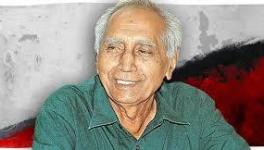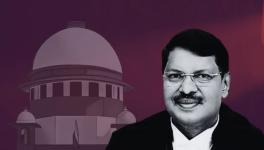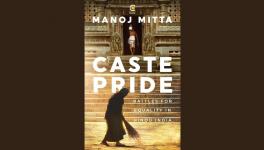Some Lessons from Ambedkar on Caste, Coronavirus and Gangs

Image courtesy Siddesh Gautam
The following observations are based not on microbiological references or epidemiological analysis and not on the medical research going on with regard to the Novel Coronavirus. While I recognise that all scientific pursuits and research is taking place with extraordinarily concentrated and frantic intensity, my own reflections occupy the space that forms in the gaps that remain within those efforts.
In fact, from what I understand, it is these gaps and the uncertainties that still grip the scientific research on the virus, that actually provoke, not a stunned silence from the general public, but rather a great rush of supplementary or substitutive discourses, views and images about the virus.
This phenomenon should not simply be dismissed as the spread of fake news on social media; it should also be seen as a desire for meaning in the face of the obscure and deadly reality of the coronavirus. My own remarks are situated in this space which describes the distance between the obscurity that surrounds the nature of the virus and the excessive meaning attached with the name “Coronavirus” today.
It seems to me that the meaning generated by the name “Coronavirus” is not the same for the different social individuals, groups or classes that are being addressed and targeted with the disciplinary strategy of social distancing and the state’s imposition of a general lockdown.
In the last one month or so, as observed in India itself, different strata and groups have responded in significantly different ways to both social distancing and the lockdown. This is not merely an empirical occurrence; it is a constitutive heterogeneity of our social structure that has manifested itself in a particular historical moment. This so-called moment—which invokes among a lot of people a sense of global and universal threat to human life, something which also leads these people to espouse the cause of global unity beyond all differences—is itself structured by heterogeneous experiences of time by different social groups though nominally living in the same territory.
This heterogeneity became graphically and painfully clear after the lockdown led to a massive displacement of the migrant working population, who were found to be stranded on open highways, hundreds of kilometres away from their villages, to where they were headed often on foot, and the immediate police blockade, which was single-mindedly interested in enforcing the spatial meaning of the lockdown, while being totally impervious to the historical reality of these people.
That is the essence of my first set of observations: social distancing as well as the lockdown are premised on a uniform spatial meaning of the name “Coronavirus”. However, the experience of the viral danger is lived out differently by different groups and strata of people in society. To my mind, social distancing is itself a disciplinary regime that is predicated on free people living in a uniform physical/architectural space. It requires the activation and disciplining of freedom—the classic condition of a modern, individualistic, even bourgeois society that does not hold for those parts of our social organisation which are not supported by either individual freedom or structural disciplinary channelisation of this freedom.
What happened after the lockdown was a kind of short-circuit of the assumptions of a disciplinary society under the global threat of the virus to our biological life. Instead, we were in the grip of a historical experience with different historical threats to our shared yet different historical lives. The sense of history is clearly manifested in widely divergent temporal trajectories through which different classes and groups reach the specific place where they are supposed to uniformly belong at this moment—a safe space-time called home. The truth however is that this moment is fraught with heterogeneities and contradictions. The announcement commanding the lockdown wanted to impose an immaculate moment and sense of history without any of these contradictions. The lockdown was supposed to be based on an unequivocal biological meaning superseding all temporal computations and productive of a single homogenous disciplinary space. The motto resoundingly repeated in this space was social distancing. However, the disciplinary motto suffered a massive historical short-circuit with the purpose of the lockdown being partially defeated by the reverse migration of the urban workers forced out onto the streets.
One way of reacting to this terrible fallout would be a sort of liberal outrage at the cynical trade-off being carried out by the current government between biological life and economic livelihood. It is an understandable outrage at the possibility that the government was willing to sacrifice the economic security of a part of the population to secure the biological lives of all the people. However, this scenario assumes that the government was looking at the entire country as one social space.
The second main conclusion that I synthesise out of my notes is that the state does not actually operate on the basis of a generalised calculation or trade-off. The state has a far greater and effective political grasp of our society than what the liberal outrage allows for. The state, in the moment of the lockdown, gambled on a bifurcated strategy that the lockdown can mediate a disciplinary and free conduct of the upper and middle classes (through social distancing) and the same lockdown would be felt by the precarious and poor masses as a direct capture of their historical lives—implying that a part of the population must purely submit to the command of the Indian prime minister in all its brutal lucidity that everyone stays at home.
What is evident is the fact that the strategy did not quite work. There are at least two reasons for this. The first is that the social organisation of India has a peculiar ritual feature, which holds true not just for one class or another but for the entire society. This ritual feature which consists dividing society into rigid segments or groups or even gangs—one of the terms Ambedkar used for caste, the more well-known and volatile of these categories. This leads to what Ambedkar calls the infection of imitation.
The singular characteristic of caste is that it spreads through mechanical ritual imitation. Further, such an imitative transmission occurs because each caste group takes the neighbouring group as a model to be imitated as well as a threat to be kept at a safe distance. This is the classic psychology of the gang: each gang is ‘infected’ by the desire to be the more powerful one and yet must avoid being captured by the latter like the plague. Hence, even within the upper classes there are internal distinctions of castes (to which other categories like gender could be added) and these distinctions intrinsically contain seeds of rigid segmentarity, enmity and pathological otherness. So it is not surprising to find upper class neighbourhoods that sing praises of doctors, other health-workers and airline employees who evacuated Indians stranded in other countries, in the same move stigmatise them out of the fear that these “heroes” carry the deadly, nay evil virus in their bodies. These contradictions or short-circuits are based on a casteist gang psychology, even if those stigmatised are not necessarily from lower castes.
The second reason for the short-circuit was that the migrant population—who are mostly from the lower social caste (or grade) and who are dominantly seen as “servants” meant to serve society as a matter of necessity instead of being seen as a part of the free disciplined workforce—broke this social image when they disobeyed the lockdown. No doubt in the first place this was a sort of involuntary or compulsory disobedience. At the same time, one cannot neglect to call it as much an existential disobedience. After all, it is not as if the people who had to take the brunt of police violence did it without at least some residual existential courage. They broke the mirror of society, which sees them in the image of the obedient servant for the obvious reason that suddenly their service was not needed, and this so-called trade-off was impossible to accept within their concrete modes of existence. This existential refusal or impossibility the state had not bargained for.
As a final exercise, I perform a certain fictional or topological deformation of the actual historical deformation as it is taking place in front of our eyes. My motive is to ask whether it is possible to soberly yet inventively think of emancipatory scenarios which indeed apply to universal humanity, but do not fall into the trap of defining this humanity by either “biological life” or “economic livelihood”. In this exercise, I suggest three scenarios: One; a scenario wherein the virus does not prompt us to consolidate ourselves as a warring army led by a great general with its different lines of heroes (and martyrs), but rather constitute a field of cooperation and what Ambedkar calls “social humanity”. This essentially means the current hierarchy that rules our lives between “essential services” and “non-essential work” is liberated from its coded caste meaning. This meaning being that some people are necessarily and essentially meant to serve others. The encrypted caste logic makes us both think of the ones providing us with essential services as heroes and at the same time as potential traitors to their essential calling. Instead an emancipatory scenario would imagine a doctor or a sanitation worker as one among us. In other words, more than at any other moment it is today under the shadow of death that we must adopt an egalitarian standpoint on society and not a martyrological one.
The second scenario intensifies the first one to the degree that in it all lives are seen as historical and historical existence cannot be reduced either to biological life or economic livelihood. In this scenario, the poor, the dispossessed and the hungry are not considered mere functions of their physiological or economic deprivations, but are thought of as embodying the value of existence. Which means that exactly when they are the most vulnerable and the most threatened, they must be thought of along the most universal amplitude. This is the amplitude of what Marx once called “generic humanity”. So, this scenario is a site for generic humanity to appear in a space otherwise populated by particular infected bodies with continuous variations of immunity and morbidity on a world scale.
The third scenario carves out this appearance out of current historical sequences which are admittedly part of attempts to improve the present situation. For instance, recently Uber corporation has offered to ferry doctors in its taxis. And a truly egalitarian imagination, instead of a martyrological one, would open up all taxis, other private modes of transport to all the people stranded on the open highways under the summer sun to make it possible for them to travel not only safely but in leisure.
Only leisure makes freedom and discipline concrete. This lesson can only be activated in a society free of the logic of imitation and infection, of the contagion of distance—which is exactly what caste is (contagion here is not a metaphor, but as real as what is caused by a natural virus). The scenario can be declared in the form of a slogan: “No social distancing (is possible) in a society to which one doesn’t belong!” However, I have to ask a further question: is it possible to turn the shattering and rigorous negativity of the above slogan into an affirmative one, can the migrant “servant” stranded on the open highway declare the revolutionary immigrant statement: “We are here, so we belong here!”? Is it possible in this scenario to hear the demand that the leisurely Uber ride, the air-conditioned Volvo bus, the spacious hotel room, the spaced-out university campus, the well-equipped corporate office, the seventh-floor empty high-rise flat… be made available here and now?
Of course, it is possible to pose a question back to me that who would make this demand. It is a serious and honourable political question and I could answer with incandescent historical names—the Proletariat, the Dalit, and so on… But that is the inaugural reopening of history itself—opening onto the new scenarios of the names of universal humanity in the time of the coronavirus. The virus is named, and so in a sense (and only in a sense), already belongs to the past; humanity’s new name is awaited and so belongs to a time to come.
Soumyabrata Choudhury currently teaches at the School of Arts and Aesthetics, JNU (Delhi). He has previously taught at CSSSC, Kolkata, and has been a fellow at CSDS, Delhi and IIAS, Shimla. He is the author of several books including Theatre, Number, Event: Three Studies on the Relationship of Sovereignty, Power and Truth (2013) and Ambedkar and Other Immortals: An Untouchable Research Programme (2018). The views expressed are personal.
Get the latest reports & analysis with people's perspective on Protests, movements & deep analytical videos, discussions of the current affairs in your Telegram app. Subscribe to NewsClick's Telegram channel & get Real-Time updates on stories, as they get published on our website.
























